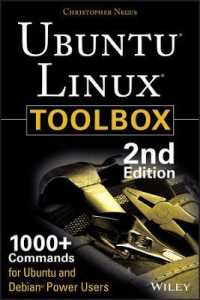- ホーム
- > 洋書
- > 英文書
- > Politics / International Relations
Full Description
By emphasizing how history, political culture, rules, and institutions influence choices that lie at the heart of governing, this book presses the reader to think about how these forces conspire to shape politics today and how they will determine the state of affairs tomorrow. The thoroughly revised fourth edition includes coverage of the political problems raised by the state's persistent drought, the widening of health care access to low-income children and adults, the increase in the state's minimum wage, controversy over legislation for mandatory vaccination of schoolchildren, and the state's precariously balanced budget.
Contents
Chapter 1Principles for Understanding California PoliticsChapter 2: Critical Junctures: California's Political History in BriefEarly CaliforniaThe Rise of the Southern Pacific RailroadProgressivismThe Power of Organized InterestsGrowth and Industrialization in the Golden StateThe Initiative Process Takes HoldHyperdiversity in a Modern StateRecalling a GovernorPushing Ahead with More ReformsThe Return of Jerry BrownConclusion: Political Earthquakes and Evolving InstitutionsChapter 3: Direct DemocracyThe Statewide Initiative ProcessReferendumRecallDirect Democracy at the Local LevelConclusion: The Perils and Promises of Hybrid DemocracyChapter 4: The State LegislatureDesign, Purpose, and Function of the LegislatureCalifornia Representatives at WorkPolicymaking and LawmakingAnnual BudgetingConstituency Service and OutreachExecutive Branch OversightLeadersConclusion: Of the People, for the PeopleChapter 5: The Executive BranchCalifornia's Plural ExecutiveCalifornia's GovernorThe Constitutional Executive OfficersAdministrators and RegulatorsConclusion: Competition for PowerChapter 6: The Court SystemThe Three-Tiered Court SystemOn and Off the CourtCourt AdministrationJuriesCriminal Justice and Its CostsConclusion: Access to JusticeChapter 7: Other GovernmentsCounty GovernmentMunicipal GovernmentsSpecial DistrictsRegional GovernmentsFederalismTribal GovernmentsConclusion: The State's Interlocking SystemsChapter 8: The California Budget ProcessCalifornia Budgeting 101Mechanics of Budgeting: RevenueMechanics of Budgeting: Deficits and ExpendituresPolitical Constraints on BudgetingTax Burden: Highest in the Nation?Conclusion: Budgeting under Variable ConditionsChapter 9: Political Parties, Elections, and CampaignsDemocratic Stronghold, but Weakly PartisanParty in the California ElectorateParty in GovernmentParty OrganizationsParty in Informal NetworksElections: Continuity and ChangeCalifornia CampaignsConclusion: A Complex ElectorateChapter 10: Political EngagementCitizens and PoliticsNews Sources and Media HabitsPolitical Engagement and DisengagementMajor Voting TrendsSpecial Interest Groups: Indirectly Connecting Citizens to GovernmentConclusion: An Evolving Political CommunityChapter 11: Concluding Thoughts: Political Paradoxes and Governability






